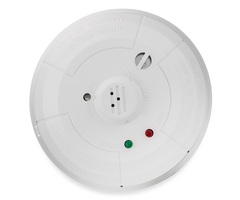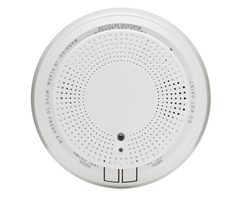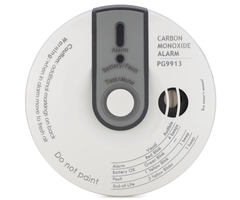Carbon Monoxide Detector Functionality
Related Products










Related Categories
Description
In this video, Joe talks about carbon monoxide detectors. A carbon monoxide detector will alert a security panel if there is an outbreak of carbon monoxide gas. Carbon monoxide gas is odorless and tasteless, making it virtually impossible to detect without a properly function carbon monoxide sensor.
Hundreds of people are killed due to carbon monoxide outbreaks every single year. Most of these deaths occur in the winter months when heaters are commonly used to heat homes. Faulty heating equipment can emit CO gas and lead to an outbreak. If you carbon monoxide detectors, then the sensors will detect the unusually high levels of the gas and alert the system before anything serious happens. Other causes of CO outbreaks can include running vehicles in poorly ventilated areas, using a charcoal grill or portable camp stove indoors, or faulty fuel-burning appliances. It's possible that a carbon monoxide outbreak could occur at any time, so you want to always make sure that these sensors are working properly. Testing them regularly is strongly recommended.
While all carbon monoxide sensors accomplish the same end goal of detecting carbon monoxide gas, these sensors can be split into many sub-categories. For example, there are wireless carbon monoxide detectors and hardwired carbon monoxide sensors. There are many of both varieties that can be directly paired with alarm systems. Wireless carbon monoxide sensors for alarm systems will communicate with an alarm control panel at a particular frequency and take up a wireless system zone. Hardwired carbon monoxide sensors for alarm systems are usually 4-wire devices that connect with a hardwired zone. With hardwired CO sensors, no reset equipment is needed because the alarm will clear when the CO gas exits the sensor.
Even carbon monoxide sensors not specifically designed for use with alarm systems can be still be used with systems by pairing them indirectly. This applies to wireless conventional CO detectors and high-voltage hardwired CO sensors. All you have to do is use a takeover listening module that will actively listen for the temporal 4 sound of an activated carbon monoxide sensor. When the listening module hears this sound it will send an alert to the alarm panel and trigger a carbon monoxide alarm. An example of a listening module used for this purpose is the Encore FireFighter FF345. You just need to make sure the listening module communicates at a wireless frequency that is compatible with your alarm system.
http://alrm.gd/get-monitored
Transcript
Hi, viewers. Joe from AlarmGrid. And today, we're going to talk about carbon monoxide detector functionality. What a carbon monoxide detector is, is a detector that detects carbon monoxide. It's very important to have inside of your home as carbon monoxide is odorless and colorless, so you can't smell it and you can't see it. It kills people in their sleep for the most part, when it does affect a home and it's a very dangerous thing to happen. If your system is monitored by a security company and you do have central station monitoring, there's a very good chance that if your carbon monoxide detector goes off that they're going to immediately send dispatch to your house from the fire department as soon as they get that signal. And in fact, there is a law that says they are required to dispatch on those signals if it comes in. So know that when you're installing a carbon monoxide detector, keep your system on test when you're putting it up because if that thing goes off and they get that alarm signal, you're going to have to deal with the fire department. Now carbon monoxide detectors, they come in three different varieties but they all will do the same thing, they detect carbon monoxide. The three different types of sensors are biomimetic, metal oxide semiconductors, and electrochemical. They all function in a slightly different way. The electrochemical sensor, they actually have sensors that have chemical painted on top of them. And when that detects carbon monoxide, it triggers the sensor. Biomimetic sensors have a gel inside of them that'll change color. When that changes color, the sensor will trigger, telling the alarm system that there is carbon monoxide in the area. And metal oxide semiconductor sensors, they have a silica chip that reacts to carbon monoxide. That will trigger the sensor when it goes off. So as you can see, all three sensors, they have a different way of activation but they'll all tell you if there's carbon monoxide present in the area. When you're going to install your carbon monoxide detectors, usually at the bare minimum, you want to put one on each floor. If you want to go above and beyond, putting them by all the sleeping areas is a good idea and in the areas nearby the garage. You don't want to put them in the area where there's fuel burning appliances or in the garage itself as that'll probably give you a false alarm. Another place you wouldn't want to install it is in a furnace room or nowhere else where there is an appliance that's burning fuel, because that gas in the room could trigger the carbon monoxide detector and that may just be normal operational gas that's not leaking into the house. Really, you want them in your living areas, nearby places that have that. So nearby the garage or nearby a utility room in the hallway. You definitely want it in all of your sleeping areas if you can. But at very least, you want one carbon monoxide detector on each floor. Other aspects of a carbon monoxide detector is that there's two different types. There's hardwired and there's wireless. If you are using a hardwired carbon monoxide detector, it is not recommended to connect it to a hardwired to wireless translator. So you're going to want a home-run these all the way back to your panel or to an expansion module that's also wired to your panel, depending on what kind of system you have. The wireless carbon monoxide detectors, they work as such, they're wireless devices. You do have to make sure that they're compatible with your systems so that you can program them into the system to make them work. One more aspect on the wired carbon monoxide detectors is that when you do set them up, you want to program them as normally open and then you want to wire the resistor at the carbon monoxide detector in parallel. This will supervise the whole line, and the reason you do normally open is that for the most part, fire devices, you want to set up as normally open devices. So the loop is open. When it triggers, it closes it, tells the system that there's carbon monoxide in the area, and will trigger an alarm. If you have any questions all about carbon monoxide detectors, how they work or how to install them, feel free to head to our website, www.alarmgrid.com. Send us an email to support@alarmgrid.com or give us a call at 888-818-7728. If you did enjoy the video, feel free to subscribe. And if you want to be notified when we post future videos, hit the notification button below and we'll send you an update when we do so. Thanks for watching and have a great day.
- Uploaded


